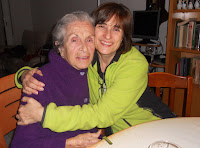3 Dialogue Lessons From a Hesitant Hug
 |
| Courtesy of morguefiles.com |
I approached her, my arms beginning to outstretch and said, "Can I give you a hug?"
She said, "OK."
She hugged me, but I laughed and pulled out of the hug.
"You're not a hugger, are you?" I said.
Her sheepish grin gave the obvious answer. No, she wasn't a hugger.
Body language and tone can tell us a lot about a person. Add their word choice and the picture becomes clearer.
Over the weekend, this wonderful writer led our workshop with an enthusiasm and energy that said to me she thrived on the opportunity to help us develop our writing skills. She taught the workshop at full-tilt, smiling and interacting with each one of us.
She did this so well that I felt a strong connection to her by the end of the weekend. A connection strong enough to prompt me to want to give her a hug of thanks. Her enthusiasm during the workshop made me feel comfortable asking.
So how did I know to pull back? How did I recognize she was not a hugger?
The combination of body language, tone, and word choice. Let's break it down.
Word Choice
"OK," is not the typical response of a hugger when asked for a hug. People who hug usually respond with a more positive word: sure, absolutely, of course, yes.
Tone
The way she said "OK" provided another clue. Her tone was not enthusiastic and bright. The pitch went down not up. The "K" part of the word was extended: ka-ay. Her tone said I really don't want to, but I will to be polite.
Body Language
Remember, she did hug me, but huggers throw their arms out and fling them around you. Her arms lifted up and around. They did not stretch outward first in the recognized indication of a hug.
Noting these three areas, I knew without a doubt, this person was not a hugger. I applaud her for recognizing a student who felt a connection and choosing to honor that connection. She could have declined explaining she didn't hug, but she accepted the hug with grace. Then we both laughed when I recognized her hesitation.
So, what is the point of this dissection of such a short, less than five second interchange?
We can learn so much from paying attention to the clues people send us...if we choose to. Or worse, we ignore the message all together. We, also, should be aware of the messages we send.
In my communication workshops, I cover the dynamics of body language, tone, and word choice and include several activities to reinforce the concepts. You need the whole picture to interpret the message.
For writers, paying attention to these three areas eliminates falling into the talking heads syndrome. We don't need to provide every little nuance, but well-chosen indications of tone and body language help the reader hear and see the full meaning. If dialogue within your book only gives us the spoken words, we're missing so much more of the message.
To learn more about body language, tone, and word choice, check out Choosing the Right Words...Or Not.
I learned a lot at the Writing In Place Conference and can't wait to share more with you in later posts, but for now, I'm off to read this wonderful lady's book, Shine, Shine, Shine. You should check it out, too. She is a phenomenal writer with a lot of great knowledge to share.


Comments